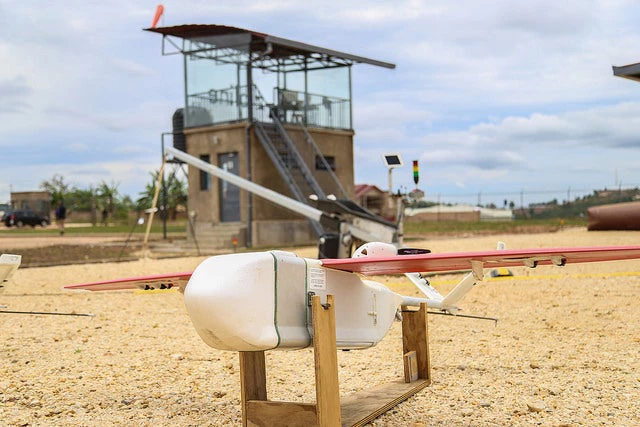
Photo: Sarah Farhat / World Bank
Recently, I was intrigued when I read a Gates Foundation tweet that asked, “How do you get access to urgent medical supplies like blood if you live in a remote community?”. The reply provided may seem at first glance far-fetched to some people: “Drones"
This reply should not surprise us since novel technologies are already disrupting different aspects of our lives. At the World Economic Forum (WEF) held last month in Davos, a topic that attracted a lot of attention was how drone delivery will change the face of global logistics. To illustrate the potential of this disruption, the experience in Rwanda’s health system was highlighted as the biggest success story in global drone operation. As reported by The Lancet, in the fall of 2017, Rwanda, in partnership with California-based robotics company Zipline International Inc., became the first country in the world to incorporate drone technology into its health care system for delivering blood and medical supplies to hospitals across its Southern and Western provinces. Moreover, the article noted that the world’s south, particularly Sub-Saharan Africa, lead the way in the use of medical drones and the developed world is slowly catching up.
The potential lifesaving impact of the rapid adoption, development, and scale-up of medical drone use is unmistakable. They could facilitate the timely availability of blood supply for medical use in hard to reach regions. I would like to argue, however, that to help fully realize the health benefits of drone technology for transporting blood, we also need to assign priority attention to reduce the risk of an infectious organism being transmitted by transfusion.

Indeed, transfusions of blood or blood-based products are a critical procedure for situations involving massive blood loss due to hemorrhage during pregnancy or child delivery (about 25% of maternal deaths worldwide result from massive obstetric bleeding that require blood transfusion). Similarly, blood transfusions are needed for women with severe anemia, which is associated with increased stillbirths, perinatal deaths, low-birth-weight babies and prematurity; victims of violence and traffic injuries involving major trauma and burns with important blood loss; as well as people requiring complicated surgery to deal with cerebrovascular diseases or an organ transplant.
The risk that contaminated blood may reach health facilities via drones for administration to unsuspecting patients by unsuspecting doctors is real. A wide variety of organisms, including bacteria, viruses, prions, and parasites can be transmitted through blood transfusions and can be deadly. For example, the transfusion of HIV-infected blood is about 100 times more efficient than intravenous drug injection with a contaminated syringe. Unsafe blood transfusions can also spread other diseases such as Hepatitis-B; Hepatitis- C, which lead in 65% of cases to the development of liver cirrhosis or cancer; syphilis; and malaria. Health workers are also at risk of infection with bloodborne viruses, as they are exposed to blood and other body fluids during their work, as we saw during the Ebola epidemic in West Africa in 2014-2015.
Reducing transfusion-transmitted infectious diseases demands that the systemic deficiency of blood services should be tackled as part of health system strengthening efforts. Well-organized, funded, staffed, and equipped blood services are needed to educate, recruit and select donors, collect and process donated blood, prepare blood products, and screen blood donations for various infectious markers and do other tests in a quality-controlled fashion. And, in coordination with health care providers, these centers are needed to follow up on the safe and appropriate use of blood and blood products (whole blood can be separated into blood products, both plasma and cellular components, such as red cells, white cells and/or platelets). Whole blood and its products also need to be stored and maintained under proper refrigeration, requiring an accurate and reliable cold chain in the health system.
The costs of delaying or neglecting action can be onerous as shown by past country experiences. During the AIDS epidemic in the 1980s, when tests to check blood for viruses were not reliable, contaminated blood supplies caused over 20,000 HIV infections in the United States alone. Similarly, the ongoing enquiry by the British Government of contaminated blood used in the UK in the 1970s and 1980s for blood transfusions attest to the gravest of this risk and its long sequelae, as thousands of NHS patients received tainted blood, ridden with Hepatitis-C and HIV, many of whom died because of transfusion-transmitted infections while others who survived are infected with Hepatitis-C.
The availability and safety of blood and blood products for transfusions will continue to pose a clear and present danger of spreading infectious diseases unless systematic improvements of blood services structures and processes is undertaken and sustained over the long-term. The enforcement of regulations, mandatory screening of blood products, and regular monitoring incorporated as part of quality control activities should priority activities in the health system. This should be coupled with the reduction of unnecessary and inappropriate blood transfusions in health facilities. Properly implemented, these measures will underpin and maximize the beneficial impact of drone technology in addressing unmet health needs of poor, vulnerable populations, living in hard-to-reach geographical regions, and save countless lives.


Join the Conversation